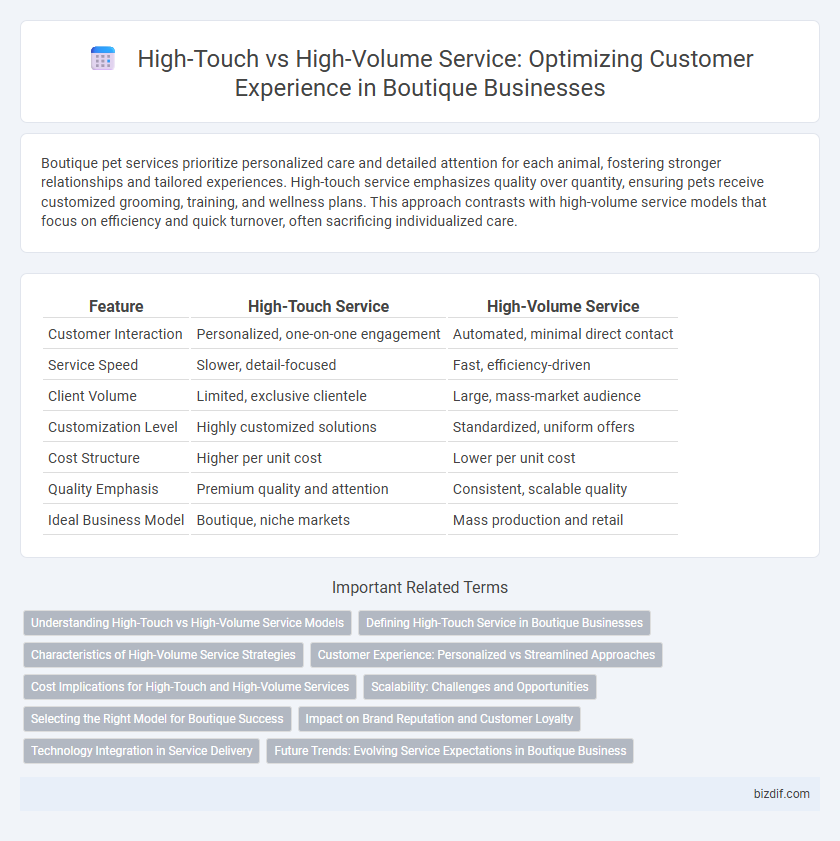Boutique pet services prioritize personalized care and detailed attention for each animal, fostering stronger relationships and tailored experiences. High-touch service emphasizes quality over quantity, ensuring pets receive customized grooming, training, and wellness plans. This approach contrasts with high-volume service models that focus on efficiency and quick turnover, often sacrificing individualized care.
Table of Comparison
| Feature | High-Touch Service | High-Volume Service |
|---|---|---|
| Customer Interaction | Personalized, one-on-one engagement | Automated, minimal direct contact |
| Service Speed | Slower, detail-focused | Fast, efficiency-driven |
| Client Volume | Limited, exclusive clientele | Large, mass-market audience |
| Customization Level | Highly customized solutions | Standardized, uniform offers |
| Cost Structure | Higher per unit cost | Lower per unit cost |
| Quality Emphasis | Premium quality and attention | Consistent, scalable quality |
| Ideal Business Model | Boutique, niche markets | Mass production and retail |
Understanding High-Touch vs High-Volume Service Models
High-touch service models prioritize personalized customer interactions and tailored experiences, often supported by skilled staff who build long-term relationships. In contrast, high-volume service models focus on efficiency and scalability, handling large numbers of customers through standardized processes and automation. Understanding these service models helps boutiques align their customer engagement strategies with their brand identity and operational goals.
Defining High-Touch Service in Boutique Businesses
High-touch service in boutique businesses emphasizes personalized interactions, tailored experiences, and deep customer engagement to meet unique client needs. This service model prioritizes quality over quantity, fostering strong relationships and customer loyalty through attentive, hands-on support. Boutique businesses leveraging high-touch service differentiate themselves by delivering exclusive, customized offerings that cannot be replicated by high-volume competitors.
Characteristics of High-Volume Service Strategies
High-volume service strategies emphasize efficiency, scalability, and standardized processes to handle large customer bases quickly and affordably. These strategies often employ automation, streamlined workflows, and mass marketing to reduce costs and increase transaction speed. The primary focus lies in delivering consistent, rapid service rather than personalized attention.
Customer Experience: Personalized vs Streamlined Approaches
High-touch service in boutiques emphasizes personalized customer experiences through tailored interactions and attention to individual preferences, fostering loyalty and satisfaction. In contrast, high-volume service prioritizes efficiency and streamlined processes, often utilizing standardized procedures to handle large customer flows quickly. Balancing these approaches depends on the boutique's target market, as personalized service enhances exclusivity while streamlined service supports scalability.
Cost Implications for High-Touch and High-Volume Services
High-touch service involves personalized interactions requiring significant labor and resources, resulting in higher operational costs per customer. High-volume service emphasizes efficiency and automation, lowering costs through economies of scale but often sacrificing customization. Businesses must evaluate their target market and cost structure to balance service quality with profitability.
Scalability: Challenges and Opportunities
High-touch service in boutiques offers personalized customer experiences but faces scalability challenges due to increased time and labor per interaction. High-volume service enables rapid client turnover by standardizing processes, yet risks compromising individualized attention and brand exclusivity. Balancing these models requires leveraging technology and staff training to optimize operational efficiency while maintaining quality service.
Selecting the Right Model for Boutique Success
Choosing the right service model is critical for boutique success, with high-touch service emphasizing personalized client interactions and bespoke experiences that foster strong loyalty and premium pricing. High-volume service prioritizes efficiency and scalability, catering to a broader audience with standardized offerings and streamlined operations. Boutiques must analyze target market preferences, operational capacity, and brand positioning to determine whether a tailored, intimate approach or a scalable, transaction-focused model best drives growth and client satisfaction.
Impact on Brand Reputation and Customer Loyalty
High-touch service in boutiques creates personalized experiences that significantly enhance brand reputation by fostering strong emotional connections and customer trust. This tailored approach drives higher customer loyalty and repeat business, as clients feel valued and understood. In contrast, high-volume service prioritizes efficiency and scale but risks diluting brand identity and weakening long-term customer relationships.
Technology Integration in Service Delivery
High-touch service emphasizes personalized customer interactions supported by advanced CRM systems and AI-driven insights to tailor experiences in boutique settings. High-volume service leverages automation technologies, such as chatbots and self-service platforms, to efficiently manage large customer pools while maintaining consistency. Technology integration in service delivery enables boutiques to balance customization and scalability, enhancing customer satisfaction and operational efficiency.
Future Trends: Evolving Service Expectations in Boutique Business
High-touch service in boutique businesses emphasizes personalized customer interactions and tailored experiences, aligning with the increasing consumer demand for authenticity and customization. Future trends indicate a shift towards integrating advanced technologies such as AI-driven customer insights and virtual consultations to enhance these personalized services without compromising intimacy. Conversely, high-volume service models risk diminishing brand loyalty as consumers prioritize meaningful engagement and unique value over rapid, transactional exchanges.
High-Touch Service vs High-Volume Service Infographic

 bizdif.com
bizdif.com